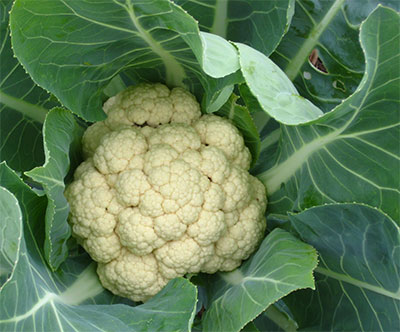AS Guyana continues to observe 2021 being International Year of Fruits and Vegetables as designated by the UN General Assembly, NAREI in Focus will be looking at cauliflower this week. Through this UN initiative, persons are being made aware of the important role of fruits and vegetables in human nutrition, food security and health and as well in achieving UN Sustainable Development Goals.
CAULIFLOWER is a member of the Cruciferae family that includes vegetables commonly grown here such as cabbage and pak choi.
Variety
Two tropical varieties grown in Guyana are Farmer’s Extra Early and Maya.
Cultivation
Grown in seedbeds/ trays and then transplanted at the four to five-leaf stage (one month)
Transplanting is best carried out in the afternoon
Spacing should be 60cm (2ft) between rows and 45cm (1 ½ ft) between plants within rows
Can be grown on sandy or clay soil but does not tolerate acidic conditions
Soil pH below 6.5 must be corrected by applying limestone at the recommended rate of at least six weeks before transplanting
Water frequently but avoid wetting the leaves and apex of the plant, as this will encourage fungal infections
Fertiliser
Conduct soil test to determine fertiliser requirement
Phosphate should be applied six weeks before transplanting
Use 270kg of TSP per hectare (230 lb/acre).
A mixed fertilizer such as 15:15:15 should be applied a few days after transplanting. An approximate guide, apply 10g (2/3 of a tablespoon), 5cm away from the plant to avoid ‘burning’ the roots. Repeat this dose at two and four weeks after transplanting.
Higher rates may be needed for very light sandy soils and lower rates may be needed for pegasse soils rich in organic matter.
Too much nitrogen such as urea will encourage excessive leaf growth and delay plant maturity
Disease
Damping-off is caused by the Pythium Fungus and may be a problem at the early seedling stage.
Symptom: narrowing of the steam near the base of the seedling which quickly turns watery, causing it to collapse.
To reduce risk, avoid overwatering and ensure that that there is good drainage.
Chemical control can be achieved by spraying the bed with Aliette (Phos-al) (1 tablespoon per gallon) before sowing.
Black Rot is a bacterial infection that first appears at the margins of the leaves. Later it may spread along veins and eventually, stems may turn black. Chemical control can be achieved by applying Trimiltox which has some bacterial action.
Leaf spot is a fungal infection that appears as dark spots on the leaves progressing to form lesions. It is a major problem during heavy rain. It can be reduced using chemical control by spraying with Trimiltox.
Pests
Mole crickets can cause losses by biting through the stems shortly after transplanting. If mole crickets are a known problem, drench the soil in Diazanon (2 tablespoon per gallon) or Fastac (1 tablespoon per gallon) before transplanting.
DiamondBack Moth- The caterpillars of this moth can eat large proportions of the leaves and kill the plants at the early seedling stage. later in the season, when the plants are larger, a small amount of leaf damage will not harm the crop. Sprays such as Halt based on Bacillus Thuringiensis (BT) are most effective against this pest and are less toxic to humans than other spray. Mix one teaspoon in a plastic bottle of water and shake well then add to one gallon of water in the sprayer.
Budworm (Heart worm)- This is also a caterpillar that kills young plants by feeding on the apex. Treatment is as for the Diamond Back Moth.
Harvesting
Cauliflower is harvested between 50 and 80 days after transplanting depending on the variety. Allow the curd to reach full size but pick when it is still compact before the branches of the curd begin to separate. It is better to pick the head when it is slightly too small rather than wait for it to spoil. Cut below the head leaving a few leaves on to protect during transportation.
Nutrition
As far as nutrition goes, cauliflower is high in vitamin C and a good source of folate. It’s fat-free and cholesterol-free and also is low in sodium content. Additionally, cauliflower contains only 25 calories in 1/6 of a medium head. This portion size also contains 2 grams of dietary fibre and only 5 grams of carbohydrate.



.jpg)








